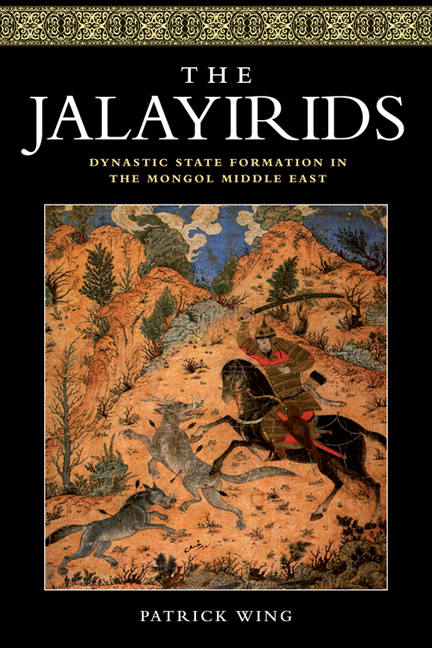Book contents
- Frontmatter
- Contents
- List of Illustrations
- Acknowledgements
- Abbreviations for Primary and Secondary Source Texts
- 1 Introduction and Sources for the History of the Jalayirids
- 2 Tribes and the Chinggisid Empire
- 3 The Jalayirs and the Early Ilkhanate
- 4 From Tribal Amirs to Royal In-laws
- 5 Crisis and Transition (1335–56)
- 6 Shaykh Uvays and the Jalayirid Dynasty
- 7 Dynastic Ideology during the Reign of Shaykh Uvays
- 8 Challenges to the Jalayirid Order
- 9 Conclusions and the Legacy of the Jalayirids
- Maps and Genealogical Chart
- Bibliography
- Index
8 - Challenges to the Jalayirid Order
- Frontmatter
- Contents
- List of Illustrations
- Acknowledgements
- Abbreviations for Primary and Secondary Source Texts
- 1 Introduction and Sources for the History of the Jalayirids
- 2 Tribes and the Chinggisid Empire
- 3 The Jalayirs and the Early Ilkhanate
- 4 From Tribal Amirs to Royal In-laws
- 5 Crisis and Transition (1335–56)
- 6 Shaykh Uvays and the Jalayirid Dynasty
- 7 Dynastic Ideology during the Reign of Shaykh Uvays
- 8 Challenges to the Jalayirid Order
- 9 Conclusions and the Legacy of the Jalayirids
- Maps and Genealogical Chart
- Bibliography
- Index
Summary
The period following the death of Sultan Shaykh Uvays was one of disruption of the central authority he had attempted to establish in Tabriz. Between 776/1374 and 788/1386 the rule of the Jalayirid sultans was challenged by the power of the amirs, who rallied support around alternative Jalayirid princes. The most powerful amir in this period was Amīr ‘Ādil Āqā, who enjoyed support from the Oyrat tribesmen, and whose authority in Sultaniyya was confirmed by Tīmūr. Power in the sultanate became divided between Tabriz, Baghdad and Sultaniyya, each home to a Jalayirid contender for the throne. In addition, this period saw the rise in influence of the Qarāquyūnlū Turkmans on the northwestern frontier, and the beginning of their at times friendly, at times hostile relations with the Jalayirids.
The political situation was turned upside down after 788/1386, with the first campaigns of Tīmūr in Iran, which fundamentally altered the balance of power and challenged the Ilkhanid legacy as promoted by the Jalayirids. Tīmūr's arrival was not immediately devastating for the Jalayirid dynasty, however, and in fact Tīmūr's conquests served to restore the authority of the sultan by eliminating his rivals. The long reign of Sulṭān Aḥmad (r. 784/1382– 813/1410) was characterised by a series of flights from Tīmūr's armies and subsequent attempts to regain control of Tabriz and Baghdad. Although Sulṭān Aḥmad was severely weakened by the Timurid campaigns, between 788/1386 and 813/1410 Jalayirid sovereignty remained important for political actors who sought to oppose or resist the Timurids. The Mamluk sultanate, the Ottoman beylik and the Qarāquyūnlū confederation all looked to the Jalayirid sultan as the embodiment of an alternative to Tīmūr in the late fourteenth century. For the Qarāquyūnlū leader Qarā Yūsuf in particular, Sulṭān Aḥmad became a link to the Ilkhanid legacy, which served as ideological capital with which to make claims to legitimate authority in Azarbayjan and Iraq in the early fifteenth century. Although the Jalayirid dynasty continued until the demise of Sulṭān Aḥmad's grandson, Sulṭān Ḥusayn, in 835/1432, the Qarāquyūnlū seizure of Tabriz following Sulṭān Aḥmad's death in 813/1410 signalled the end of the symbolic significance of Jalayirid sovereignty in the former Ilkhanid lands.
Information
- Type
- Chapter
- Information
- The JalayiridsDynastic State Formation in the Mongol Middle East, pp. 147 - 184Publisher: Edinburgh University PressPrint publication year: 2016
